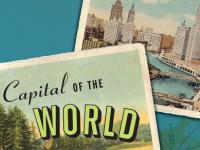Do you want to know a little known fact about Philadelphia? This nation’s first capital was in the running to become the globe’s first capital too! Nowadays many refer to New York City as the “cultural capital of the world”, for various and some obvious reasons. Beyond the apparent diversity of its inhabitants, New York City has hosted the United Nations Headquarters for over 60 years, hence the "world capital". Back in the 1940s, New York City was not a shoe-in location however; over 200 cities and townships throughout the globe strived, campaigned and lobbied to become the host of the United Nations Headquarters. Philly was not only one of hundreds competing to become this global capital, but it just about persuaded the world’s diplomats to call Philadelphia home - until an unexpected turn of events.
For the diplomats in search of a home for the U.N., the primary question to answer was whether a European center (as a traditional place of diplomacy) or a United States location (for a fresh start) would be the direction to follow. If the capital was not going to be European, at least it should be close; therefore, a spot on the northeast edge of North America would be ideal, just across the Atlantic Ocean. Diplomats looked at areas around Boston and New York City. Philadelphia was initially considered to be too close to Washington DC, and the U.N. did not want be influenced by any national capital. Still, the city produced booklets, sent politicians and prominent members of the city to conferences, and introduced Philadelphia, the City of Brotherly Love, as an ideal place for the capital of diplomacy. View our photos chronicling Philadelphia’s bid to host the U.N. Headquarters.
Major cities seemed to have an advantage in the competition because of easier access to cultural amenities, hospitals, and universities. After visiting various locations in the U.S. and abroad, U.N. delegates chose Greenwich, CT, a suburbs north of NY. Surprisingly, the citizens of Greenwich resisted their town's nomination to host the U.N. because they never campaigned nor volunteered for such a job. Therefore, delegates continued their search; they went to San Francisco, then Boston and finally to Philadelphia.
The U.N. delegates, accompanied by political and prominent Philadelphian leaders, visited the Belmont Plateau, which was immediately attractive to the delegates. Philadelphia quickly became the favorite choice. A Fairmount Park location and a Montgomery County site in Chestnut Hill were proposed and blueprinted. Delegates were shown maps that planned the site and highlighted routes and access points to cultural and historic places, amenities, train stations, highways, expressways and administrative centers. Philly was signatures away from becoming the capital of the world!
Meanwhile, New Yorkers were competing hard and enticed the U.N. to Flushing Meadows in Queens, NY. At this time, Nelson A. Rockefeller came back from a vacation to confer with delegates, NY politicians and other influential members of their society. They proposed what NY could do to solidify its place as home to the U.N.; John D Rockefeller made a gift of $8.5 million to purchase a site in Manhattan. That site is now the U.N. headquarters.

